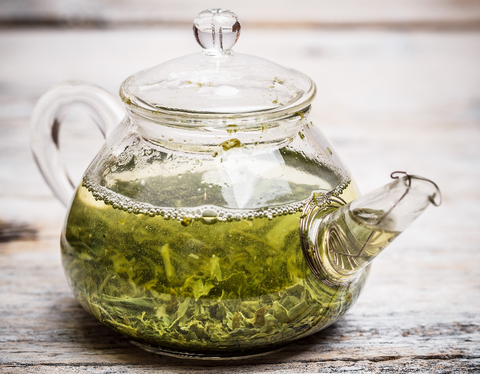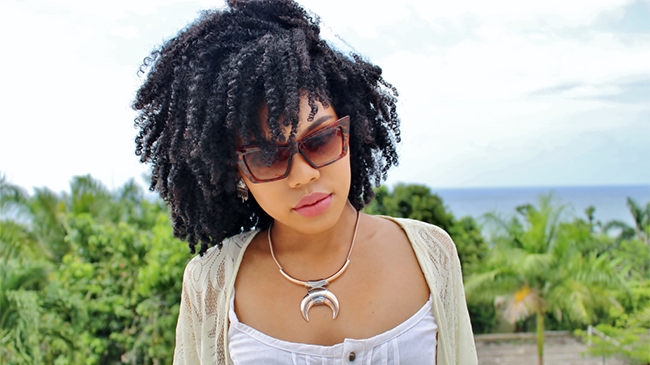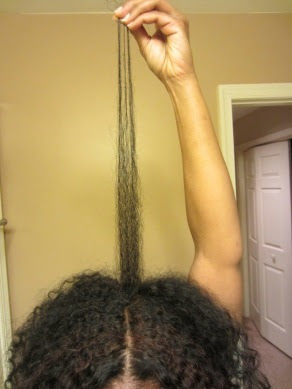Tell me a little about yourself and your hair journey.
I’m Nacketia Knight, mother of one from the beautiful paradise island of Jamaica. I have been natural for most of my life but did not start my journey until October 2011. I transitioned for a year, did a small chop ( there really wasn’t much left to cut off) and never looked back since.
Read On!>>>
How long have you been natural? Have you always embraced your curls?
I have been natural for most of my life and did not get my first relaxer until I was 18. I did not however always consider my natural hair to be beautiful, prior to my relaxer i kept my hair natural mainly because it seemed cheaper. I did not go to salons so I learned how to style my hair myself but I lacked the knowledge I now have in keeping my hair moisturized and therefore my hair never grew to even shoulder length. At 18 I believed i was mature enough to handle relaxed hair. I was in love! My hair flourished for the first year or so then it started breaking. Then came the weaves to add volume and serve as a protective style but my hair kept breaking so I went short with a mohawk. It was edgy and cute and low maintenance however when I came due for a relaxer in October 2011, I had a rude awakening. For some reason my hair did not favor the relaxer and a couple of days later, all my edges and nape was completely gone. At this point, I was done with relaxers because it was doing more harm than good.
What motivated you to transition? Were you a transitioner or a Big Chopper& why?
Having no hair on my edges and nape was my biggest motivation to transition. Looking back, I wished I had just big chopped but at the time, I did not have the courage to walk around with a bald head reason being I know this head is bigger than average and shaped weirdly plus have you seen my ears, they stick right out the sides sooo I was very self conscious. Instead, I opted to wear braids for a year and then just cut off what relaxed ends that were left at that point.
How would you describe your hair?
I would describe my hair as thick 4c hair that requires gentle and patient handling or else she will act out.
What do you love most about your hair?
I love the attention and adoration that my hair gets. She is like her own person and inspires people on a daily. I also like the versatility I can be kinky and curly with a wash and go or a flat twist out this week and next week I can flat iron and have straight hair. What i do love the most about my natural hair is how healthy it is! Ditching the relaxer and starting a healthy natural hair journey has allowed me to experience the healthiest longest hair I have had in my life. I can truly say going natural was the best choice for my hair.
What has been the most memorable part of your journey?Has it been easy or difficult or both?!
The journey did not start out easy but the longer you are natural the more you learn about your hair and it does get easier. Plus there is so much information available that you don’t have to rush into a total panic when you hair isn’t acting right. My most memorable part of the journey is off course when i decided to wear my natural hair. The reign of the braids were over and i was excited yet hesitant because i didn’t know how people would react. The feedback was mixed but i rocked it out as best as I could and here I am today a proud naturalista.
What are (or were) some of your favorite transitioning hairstyles or current dos’?
During my transition I only wore braids which is still a great protective style for me but my favorite styles right now are updo’s because they can last a while , they turn a lot of heads and are great for any occasion.
What have your experiences been as a ‘natural’? Any memorable reactions from family or others?
The reactions have been great and not so great. People in general are afraid of change and when I decided to rock my natural hair after a year of growing it out not everyone was as enthused as I was. A couple family members questioned what was going on with my hair and were not very encouraging. Fast forward 2 years later and those same family member are in awe and one even took the step to go natural herself.
What is your hair regimen?
I don’t have a hair regimen that I stick to religiously. I just try to give my hair what it needs keeping it moisturized and keeping heat usage and styling to a moderate level. I try to add shea butter to my hair every chance I get ( my hair loves that thing) and coconut oil and caster oil have been a staple since I started my journey. I keep experimenting with styling products and so far the creme of nature with Argan oil line has been great especially their shampoo ( so moisturizing to the hair).
What are some of your favorite natural hair websites,YouTuber’s, or blogs?
I learned most that I know about natural hair through Youtube and the first youtuber I used to watch is Kimmay youtube. She really inspired me and gave me hope that my natural hair could grow past shoulder length. My favorite more recent youtubers include Naptural85 , naturalme4c , blackizbeautiful , kinkystyles1980, fusionofcultures, toyaloves, nikkimae2003 iknowlee and Joulzey
Anything you want the readers to know? Inspirational words?
Natural hair is fun and beautiful, does require some time and patience but once you get the hang of it is so rewarding. If your afraid to take that step to go natural, don’t be there are so many curl friends out here to help you along the way and a plethora of information to answer all your questions. So take the step be creative and stay inspired!
Where can people find you for more information?
You can find me on youtube @Jamaican Jairgoddess where I share creative natural hairstyles as well as on IG and twitter @jahairgoddess
Global Couture is trying to spread the word about embracing your natural hair. Love your HAIR, if it is wavy, curly, kinky or coily.
Are you naturally fierce? Email us to share your hair journey at globalcouture@aol.com

















 by now. Well, it doesn’t disappoint! This oil contains monounsaturated fatty acids and vitamin E, which both help promote hair growth and length retention, decrease breakage, and strengthen the hair. Coconut oil
by now. Well, it doesn’t disappoint! This oil contains monounsaturated fatty acids and vitamin E, which both help promote hair growth and length retention, decrease breakage, and strengthen the hair. Coconut oil
 has a low weight (which helps seal the hair) and consists of hydrophobic properties that allow it to draw moisture from the atmosphere into the hair, which helps the hair retain moisture.
has a low weight (which helps seal the hair) and consists of hydrophobic properties that allow it to draw moisture from the atmosphere into the hair, which helps the hair retain moisture. is definitely one of the best and most versatile oils for natural hair and can be used for all of the purposes we listed at the beginning. It’s great to use as a prepoo or mixed into your favorite conditioner because it will naturally help melt the tangles out of your hair. You can apply coconut oil to your scalp to assist in alleviating dandruff, or simply apply it to your hair to style, add shine, combat frizz, moisturize, and seal.
is definitely one of the best and most versatile oils for natural hair and can be used for all of the purposes we listed at the beginning. It’s great to use as a prepoo or mixed into your favorite conditioner because it will naturally help melt the tangles out of your hair. You can apply coconut oil to your scalp to assist in alleviating dandruff, or simply apply it to your hair to style, add shine, combat frizz, moisturize, and seal. consists of unsaturated fatty acids, vitamin E, protein, and minerals that work together to make it one of the best oils for boosting hair growth. You’ve probably heard of using
consists of unsaturated fatty acids, vitamin E, protein, and minerals that work together to make it one of the best oils for boosting hair growth. You’ve probably heard of using  to help regrow your edges or simply to kickstart your growth journey. The rumors are true: this unrefined and nutrient-rich oil increases blood flow to the scalp, resulting in thicker, stronger, and longer hair. This is because castor oil
to help regrow your edges or simply to kickstart your growth journey. The rumors are true: this unrefined and nutrient-rich oil increases blood flow to the scalp, resulting in thicker, stronger, and longer hair. This is because castor oil has anti-bacterial and anti-fungal properties that remove dead skin cells from the scalp and stimulate hair follicles for growth.
has anti-bacterial and anti-fungal properties that remove dead skin cells from the scalp and stimulate hair follicles for growth. is a great natural way to combat all of these issues.
is a great natural way to combat all of these issues. is its own natural conditioner: it penetrates the hair shaft better than some other oils and nourishes, softens, and strengthens the hair.
is its own natural conditioner: it penetrates the hair shaft better than some other oils and nourishes, softens, and strengthens the hair.  also has an anti-inflammatory property that helps rid the hair of dandruff and product build-up on the scalp. It also assists in reducing hair loss by fortifying the hair against any kind of wear and tear.
also has an anti-inflammatory property that helps rid the hair of dandruff and product build-up on the scalp. It also assists in reducing hair loss by fortifying the hair against any kind of wear and tear. works very well for scalp massages: it will help you stimulate hair growth and maintain a healthy scalp. Add it to your spray bottle mix to help keep your hair moisturized throughout the week. Since
works very well for scalp massages: it will help you stimulate hair growth and maintain a healthy scalp. Add it to your spray bottle mix to help keep your hair moisturized throughout the week. Since  penetrates the hair shaft, it also works great for hot oil treatments and will result in hair that looks and feels softer and stronger.
penetrates the hair shaft, it also works great for hot oil treatments and will result in hair that looks and feels softer and stronger. has an even higher content (72%) of monounsaturated fats than coconut oil
has an even higher content (72%) of monounsaturated fats than coconut oil : these fats provide nourishment and make your hair super shiny.
: these fats provide nourishment and make your hair super shiny. to your shampoo will treat dry, itchy scalp and adding it to your conditioner will give you excellent slip to make detangling a breeze. It’s not heavy enough to be ideal for being used to seal moisture into the hair, but it does actually help moisturize the hair so always keep it handy to fight dryness.
to your shampoo will treat dry, itchy scalp and adding it to your conditioner will give you excellent slip to make detangling a breeze. It’s not heavy enough to be ideal for being used to seal moisture into the hair, but it does actually help moisturize the hair so always keep it handy to fight dryness. doesn’t always get as much “shine” (no pun intended) as it deserves. Much like avocado oil
doesn’t always get as much “shine” (no pun intended) as it deserves. Much like avocado oil , it is great for addressing dry scalp but also hair loss, and in preventing split ends. But unlike any other oil, jojoba mimics your hair’s own natural oil (sebum) which causes your strands to respond quite positively by absorbing it into the hair shaft, which results in more moisturized and shinier hair. It contains vitamins A, B1, B2, B6, and E, which work together to protect against damage. It has an even higher content of monounsaturated fats than avocado oil
, it is great for addressing dry scalp but also hair loss, and in preventing split ends. But unlike any other oil, jojoba mimics your hair’s own natural oil (sebum) which causes your strands to respond quite positively by absorbing it into the hair shaft, which results in more moisturized and shinier hair. It contains vitamins A, B1, B2, B6, and E, which work together to protect against damage. It has an even higher content of monounsaturated fats than avocado oil (98%!) which of course make it excellent for strengthening the hair against breakage. It adds volume, encourages hair growth, and helps the hair revert from damage.
(98%!) which of course make it excellent for strengthening the hair against breakage. It adds volume, encourages hair growth, and helps the hair revert from damage. also works great for scalp massages because it gives you great benefits without weighing your hair down. It is excellent when used in deep conditioners because it helps the hair bounce back, especially from heat styling.
also works great for scalp massages because it gives you great benefits without weighing your hair down. It is excellent when used in deep conditioners because it helps the hair bounce back, especially from heat styling.









































